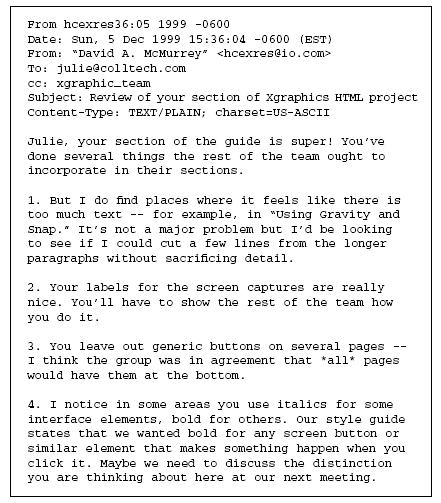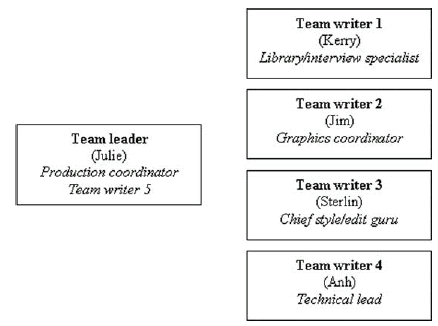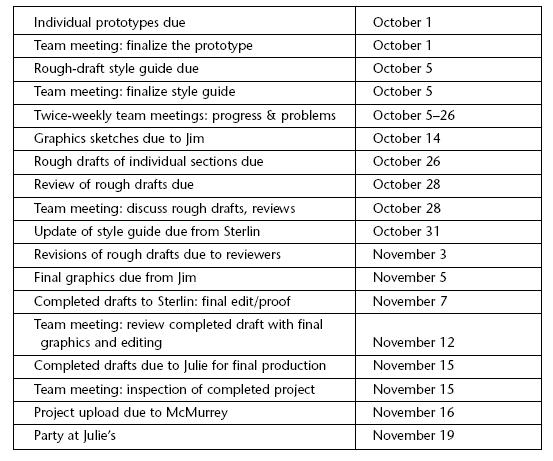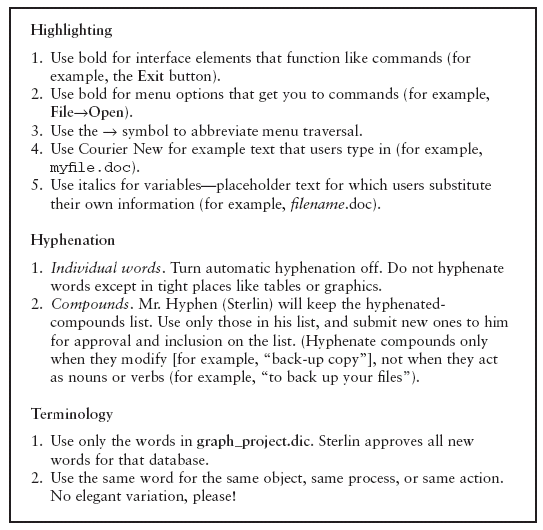Peer reviewing (also called peer-editing) means people getting together to read, comment on, and recommend improvements on each other’s work. Peer-reviewing is a good way to become a better writer because it provides experience in looking critically at writing. Peer reviewing is also important in team writing: it’s how individual team members review each other’s drafts of the writing project.
Team writing, as its name indicates, means people getting together to plan, write, and revise writing projects as a group, or team. Another name for this practice is collaborative writing—collaborative writing that is out in the open rather than under cover (where it is known as plagiarism).
Strategies for Peer Reviewing
When you peer-review another writer’s work, you evaluate it, criticize it, suggest improvements, and then communicate all of that to the writer. As a first-time peer-reviewer, you might be a bit uneasy about criticizing someone else’s work. For example, how do you tell somebody his essay is boring? Read the following discussion; you’ll find advice and guidelines on doing peer reviews and communicating peer-review comments.

Initial meeting. At the beginning of a peer review, the writer should provide peer reviewers with notes on the writing assignment and on goals and concerns about the writing project (topic, audience, purpose, situation, type), and alert them to any problems or concerns. As the writer, you want to alert reviewers to these problems; make it clear what goals you are trying to accomplish within the document. Similarly, peer reviewers should ask writers whose work they are peer-reviewing to supply information on their objectives and concerns. The peer-review questions should be specific like the following:
- Does my explanation of a virtual machine make sense to you? Would it make sense to our least technical customers?
- In general, is my writing style too technical? (I may have mimicked too much of the engineers’ specifications.)
- Are the chapter titles and headings indicative enough of the following content? (I had trouble phrasing some of these.)
- Are the screenshots clear enough? (I may have been trying to include too much detail in some of them.)
Peer-reviewing strategies. If you are new to peer-reviewing, you want to make sure that your review is comprehensive. Consider all aspects of the draft you’re reviewing, not just the grammar, punctuation, and spelling.
Read the draft several times, looking for a complete range of potential problem areas:
- Interest level, adaptation to audience
- Persuasiveness, purpose
- Content, organization
- Clarity of discussion
- Coherence, clear transitions
- Title, introduction, and conclusion.
- Sentence style and clarity
- Handling of graphics
- Be careful about making comments or criticisms that are based on your own personal style. Base your criticisms and suggestions for improvements on generally accepted guidelines, concepts, and rules. If you do make a comment that is your own preference, explain it.
- Explain the problems you find fully. Don’t just say a paper “seems disorganized.” Explain what is disorganized about the document. Use specific details from the draft to demonstrate your case.
- Whenever you criticize something in the writer’s draft, try to suggest some way to correct the problem. It’s not enough to tell the writer that her paper seems disorganized, for example. Explain how that problem could be solved; provide the writer with possible revisions.
- Base your comments and criticisms on accepted guidelines, concepts, principles, and rules. It’s not enough to tell a writer that two paragraphs ought to be switched, for example. State the reason why: “I suggest moving this general, introductory information so it appears first.”
- Avoid rewriting the draft that you are reviewing. In your efforts to suggest improvements and corrections, don’t go overboard and rewrite the draft yourself. Doing so takes away ownership of the document from the writer and steals from the writer the opportunity to learn and improve as a writer.
- Provide positive, encouraging comments about the draft you’re reviewing. Compliments, even small ones, are usually wildly appreciated. Read through the draft at least once looking for aspects that were done well, and then let the writer know about them.
How to Offer Your Peer Advice
Students often worry about the peer review process, especially if they have never been asked to peer review before in a classroom setting. The textbook English for Business Success explains that the best way to address this fear is to accept that you will be unable to locate every error or weakness. Once you understand that the process is not perfect, it is easier to feel comfortable with your role as the reviewer. Here are a few tips that will help you during the peer review process:
- Begin by reading the assignment instructions. Your instructor will likely have clear goals for the peer review process, and following the instructions will help you provide significant and meaningful revision ideas for your peer.
- Read your peer’s writing from the beginning to the end without adding any comments. This first read allows you to grasp your peer’s intentions and focus.
- Complete a second reading of your peer’s draft and start looking for strengths and weaknesses. Make comments on the margins of your peer’s writing. Later, you can further expand on these comments when you complete the peer review.
- When you feel stuck, stop and ask yourself “If this was my writing, how would I revise?”
- Set aside time to review the organization of your peer’s writing.
- Be honest. Your peers want to earn the best grade they can and your advice during peer review will help them achieve this goal. Think of every piece of advice as constructive criticism. Your advice will help them to create a stronger, more focused writing sample.
The peer review process has the potential to help you create a much stronger and more focused essay. Try to be open to the process and give honest and thoughtful critiques.
Adapted from “Chapter Seven” of English for Business Success, 2012, used according to creative commons CC BY-NC-SA 3.0
Peer-review summary. Once you’ve finished a peer review, it’s a good idea to write a summary of your thoughts, observations, impressions, criticisms, or feelings about the rough draft. See the peer-reviewer note below, which summarizes observations on a rough draft. Notice in the note some of the following details:
- The comments are categorized according to type of problem or error—grammar and usage comments in one group; higher level comments on content, organization, and interest-level can be placed in another group.
- Relative importance of the groups of comments is indicated. The peer-reviewer indicates which suggestions would be “nice” to incorporate, and which ones are critical to the success of the writing project.
- Most of the comments include some brief statement of guidelines, rules, examples, or common sense. The reviewer doesn’t simply say “This is wrong; fix it.” He also explains the basis for the comment.
- Questions are addressed to the writer. The reviewer is double-checking to see if the writer actually meant to state or imply certain ideas.
- The reviewer includes positive comments to make about the rough draft, and finds non-antagonistic, sympathetic ways to state criticisms.

Spend some time summarizing your peer-review comments in a brief note to the writer. Be as diplomatic and sympathetic as you can!
Higher and Lower Order Concerns
After you have written a draft of your document, you will need to make changes. While you may feel that you write best “under pressure” the night before your assignment is due or in the minutes before sending an email at work, writing a single draft at the last minute rarely results in anyone’s best work. You may feel that you’ve put a lot of effort into your first draft, so it can be challenging to think about changing your work or even eliminating words that you toiled over. However, it’s well worth the pain of revising, editing, and proofreading so you produce a polished piece of writing that others can easily understand. To revise a piece of writing, it may help you to consider three approaches: look at the big picture, check your organization, and proofread your final draft.

Higher Order Concerns
Revising for higher order concerns means working on the organization of your ideas. You might insert sentences, words, or paragraphs; you might move them elsewhere in your document; or you might remove them entirely (Meyer, 2017).
When you revise at the “big picture” stage, you are looking at the most important aspects of the writing tasks, and the ones that require the most thought. Here’s a set of questions to help you revise for these higher order concerns:
- Have I met the purpose and requirements?
- Does my draft say what I mean?
- Have I changed my thinking through writing or researching?
- Are there parts that do not belong here?
- Are there pieces missing?
- Are there places where the writing does not make sense?
- Is the tone right for my reader?
- Are my sources the right kind for my purpose and reader?
- Are all the pieces in the right place?
- Are sources documented?
Another way to edit for higher order concerns is to prepare a reverse outline using your draft.
Lower Order Concerns
Lower order concerns focus on editing and proofreading. When you edit, you work from your revised draft to systematically correct issues or errors in punctuation, grammar, spelling, and other issues related to writing mechanics (Meyer, 2017). Proofreading is the last stage where you work from your almost-finished document to fix any issues or errors in formatting or typos you missed (Meyer, 2017). Here’s another way of distinguishing these two tasks. Editing is the act of making changes or indicating what to change; proofreading means checking to make sure those changes were made.
Perhaps you are the person who proofreads and edits as you write a draft, so when you are done drafting and revising for content and structure, you may not have that much editing or proofreading to do. Or maybe you are the person who pays no attention to grammar and spelling as you draft, saving all of the editing until you are finished writing. Either way, plan to carefully edit and proofread your work. For most people, proofreading on a printed copy is more effective than working entirely on screen.
Here are some additional strategies for editing and proofreading your work:
- Take a break between writing and editing. Even a 15 minute break can help you look at your document anew.
- Read your work aloud.
- Work through your document slowly, moving word by word.
- Start at the end of your document and work towards the beginning.
- Focus on one issue at a time. Trying to look for spelling errors, punctuation issues, awkward phrasing, and more all at once can make it easier to miss items needing correction.
- Don’t rely exclusively on spelling- or grammar-checking software. (This poem was run through such a program and no problems were detected!)
- Review through your document several times.
Adapted from “Higher order versus lower order concerns” in The Word on College Reading and Writing by M. Babin, C. Burnell, S. Pesznecker, N. Rosevear, and J. Wood and is used under a CC-BY-NC 4.0 International license.
Strategies for Team Writing
As mentioned earlier in this chapter, team writing is one of the common ways people in the worlds of business, government, science, and technology handle large writing projects.
Assembling the team. When you begin picking team members for a writing project in a technical writing course, choose people with different backgrounds and interests. Just as a diverse, well-rounded background for an individual writer is an advantage, a group of diverse individuals makes for a well-rounded writing team.
If you are the team leader, you might even ask prospective team members for their background, interests, majors, talents, and aptitudes. These following writing teams combine individuals with diverse backgrounds and interests:
|
Writing Team 1 |
|
|
Project: |
A report on current cloaking technologies |
|
Team members |
Backgrounds, skills, interests |
|
Shawn S. |
Electrical engineering major, currently doing basic office-management chores at a law firm |
|
Tracey K. |
Senior English major, hoping this course helps with employment prospects |
|
Sanjiv Gupta |
Computer science major, currently doing computer graphics at a software development shop |
|
Jeon Chang Yeon |
Soon-to-be electrical engineering major, still developing English language skills |
|
Alice B. |
Undeclared major with a nontechnical focus, possibly in the wrong course, no stated skills |
Table 1: Visual illustration of example team members
Planning the project. Once you’ve assembled your writing team, most of the work is the same as it would be if you were writing by yourself—except that each phase is a team effort. Specifically, meet with your team to decide or plan the following:
Planning Stages
- Analyze the writing assignment.
- Pick a topic.
- Define the audience, purpose, and writing situation.
- Brainstorm and narrow the the topic.
- Create an outline.
- Plan the information search (for books, articles, etc., in the library).
- Plan a system for taking notes from information sources.
- Plan any graphics you’d like to see in your writing project.
- Agree on style and format questions (see the following discussion).
- Develop a work schedule for the project and divide the responsibilities (see the following).
Table 2: Planning stages for team writing
Capture your team’s profiles and decisions in a simple team-planning document. It can contain the key dates in the team schedule, a tentative outline of the document to be team-produced, formatting agreements, individual writer assignments, word-choice preferences, and so on. Mention is made below of a by-laws document. That can be incorporated in the team plan as well.
Much of the work in a team-writing project must be done by individual team members on their own. However if your team decides to divide up the work for the writing project, try for at least these minimum guidelines:
- Have each team member responsible for the writing of one major section of the paper.
- Have each team member responsible for locating, reading, and taking notes on an equal part of the information sources.
Some of the work for the project that could be done as a team you may want to do first independently. For example, brainstorming, narrowing, and especially outlining should be done first by each team member on his own; then get together and compare notes. Keep in mind how group dynamics can unknowingly suppress certain ideas and how less assertive team members might be reluctant to contribute their valuable ideas in the group context.
After you’ve divided up the work for the project, write a formal chart and distribute it to all the members.

Scheduling the project and balancing the workload. Early in your team writing project, set up a schedule of key dates. This schedule will enable you and your team members to make steady, organized progress and complete the project on time. As shown in the example schedule below, include not only completion dates for key phases of the project but also meeting dates and the subject and purpose of those meetings. Notice these details about that schedule:
- Several meetings are scheduled in which members discuss the information they are finding or are not finding. (One team member may have information another member is looking everywhere for.)
- Several meetings are scheduled to review the project details, specifically, the topic, audience, purpose, situation, and outline. As you learn more about the topic and become more settled in the project, your team may want to change some of these details or make them more specific.
- Several rough drafts are scheduled. Team members peer-review each other’s drafts of individual sections at least twice, the second time to see if the recommended changes have worked. Once the complete draft is put together, it too is reviewed twice.

Anticipating problems and creating team by-laws. In a workplace setting, you can think ahead to resolve typical problems that can arise in a team project and document your team’s agreements about these matters in a by-laws document:
- Workload imbalance. When you work as a team, there is always the chance that one of the team members, for whatever reason, may have more or less than a fair share of the workload. Therefore, it’s important to find a way to keep track of what each team member is doing. A good way to do that is to have individual team members keep a journal or log of what kind of work they do and how much time they spend doing it.
- Both during and at the end of the project, if there are any problems, the journal should make the issue very clear and enable a more equitable balancing of the workload. At the end of the project, team members can add up their hours spent on the project; if anyone has spent a little more than her share of time working, the other members can make up for it by buying her dinner or another similar reward. Similarly, as you reach the end of the project, if it’s clear from the journals that one team member’s work responsibilities turned out, through no fault of his own, to be smaller than those of the others, he can make up for it by doing more of the finish-up work such as typing, proofing, or copying.
- Team members without relevant skills. As you can see in the example description of team members’ skills above, one member has no relevant skills with which to contribute to the project. Sometimes, that’s just an indication of that person’s anxiety or lack of interest in engaging in a group project. Of course, each team member in a writing course should contribute a fair share of the writing for a project. However, there are plenty of tasks that do not require technical knowledge, formatting skills, or a sharp editorial eye, for example: typing up and distributing the team plan, the by-laws, minutes of team meetings; reminding team members of due dates and scheduled meetings. In fact, except for the anxiety or lack of interest, the self-professed unskilled team member might make the best team leader!
- Disappearing team members. If your team is so unfortunate as to have an irresponsible member who simply vanishes, have a plan for what to do about that, and document it in your team by-laws. One obvious solution is to kick the team member off the team and inform the instructor if it’s a writing course or the next level of management if it’s a nonacademic organization.
- Seemingly entrenched team-member disagreements. It is amazing how vehemently team members can disagree on aspects of a team-writing project. In order to prepare for this possibility, have a plan, written in your team by-laws, that addresses how team members can resolve these matters. Should they be put to a vote? Should you “escalate” the matter to a neutral or higher-level party?
- Radically inconsistent writing styles and format. Because the individual sections will be written by different writers who are apt to have different writing styles, set up a style guide in which your team members list their agreements on how things are to be handled in the paper as a whole. These agreements can range from the high level, such as whether to have a background section, all the way down to picky details such as when to use italics or bold and whether it is “click” or “click on.” See the excerpt from a project style sheet in the following. For discussion of these items, see stylesheets and style guides.
- Before you and your team members write the first rough draft, you can’t expect to anticipate every possible difference in style and format. Therefore, plan to update this style sheet when you review the rough draft of individual sections and, especially, when the team reviews the complete draft.

The items listed in Figure 4 represent agreements team writers have made in order to give their paper as much consistency as possible.
Reviewing drafts and finishing. Try to schedule as many reviews of your team’s written work as possible. You can meet to discuss each other’s rough drafts of individual sections as well as rough drafts of the complete paper. When you do meet, follow the suggestions for peer-editing.
A critical stage in team-writing a paper comes when you put together into one complete draft those individual sections written by different team members. It’s then that you’ll probably see how different the tone, treatment, and style each section is. You must as a group find a way to revise and edit the complete rough draft to make it read consistently so that it won’t be so obviously written by three or four different people.
When you’ve finished with reviewing and revising, it’s time for the finish-up work to get the draft ready to hand in. That work is the same as it would be if you were writing the paper on your own, only in this case the workloads can be divided up.
Adapted from “Strategies for Peer Reviewing and Team Writing” in Online Technical Writing by David McMurrey, which is is licensed under a CC BY-SA 4.0 International License.